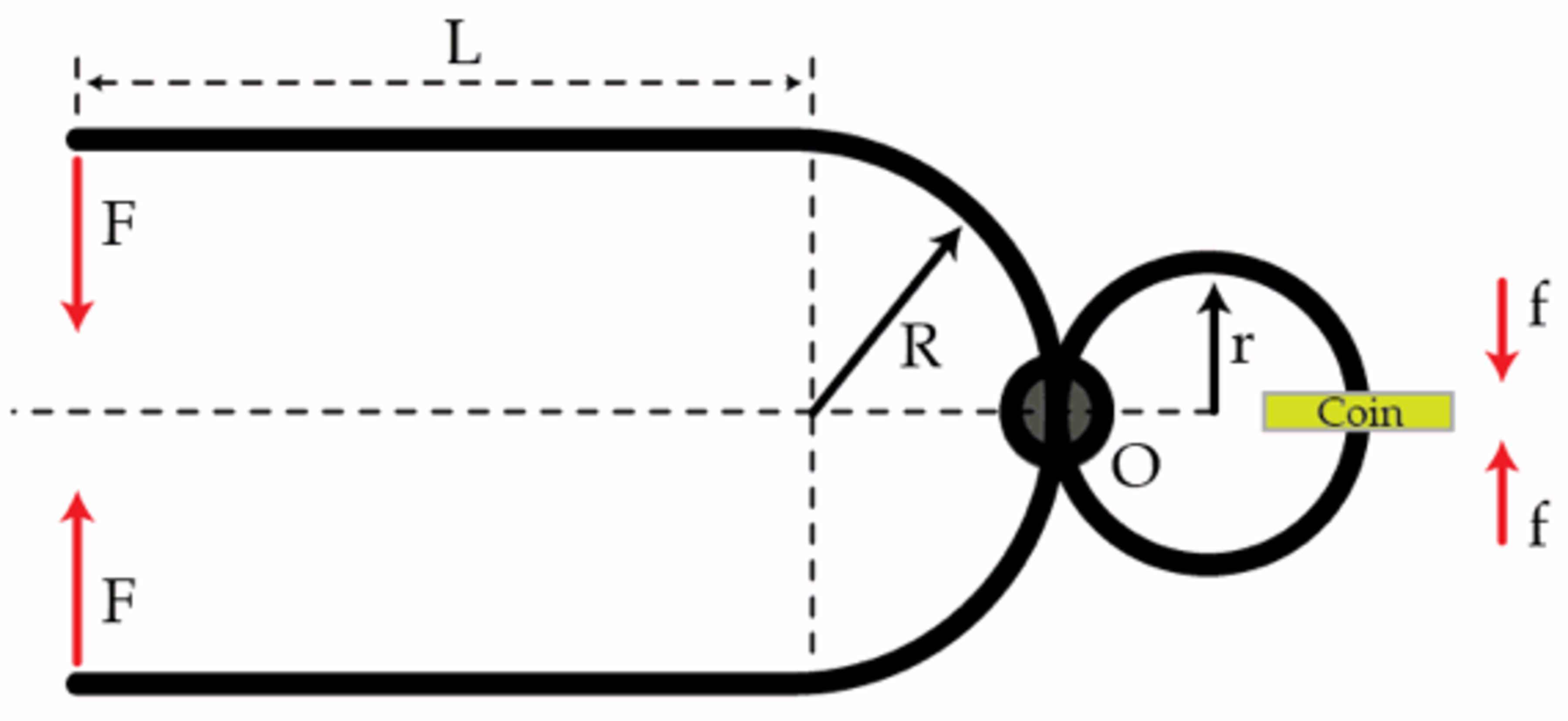A pair of pliers
The figure shows a simple model of a pair of pliers consisting of two handles of length L = 1 0 cm , a semicircle of radius R = 4 cm , a fulcrum (point O) and the jaws having a radius of curvature r = 1 cm . Using these pliers, you grab a coin and apply a force F = 1 0 N to the handles as shown in the figure. What is the force f in Newtons pressing on each side of the coin? You may neglect the thickness of the coin.

The answer is 70.
This section requires Javascript.
You are seeing this because something didn't load right. We suggest you, (a) try
refreshing the page, (b) enabling javascript if it is disabled on your browser and,
finally, (c)
loading the
non-javascript version of this page
. We're sorry about the hassle.
7 solutions
This can be solved using the Archimedes' lever law .
i.e F a = f b here a = L + R and b = 2 r .
⇒ f = b F a
On substituting the values f = 2 × 1 1 0 × ( 1 0 + 4 ) = 7 0 N
Since the coin is in Rotational Equilibrium ,the net External Torque on the coin is 0 . Choosing the hinge as origin,the torques(moments) could be equated as: F.(L + R) = f 2r which gives f = 70N
Let us start from identifying the physical principle behind the problem. Upper handle is connected to lower jaw. Hence the torque acting at the tip of upper handle about the fulcrum is equal to the torque acting at the tip of lower jaw about the fulcrum. Same holds true for lower handle and upper jaw. Using simple geometry we can calculate the distance between fulcrum and tip of handle to be 0 . 1 4 5 6 m . Also it easy to calculate from geometry the sine of the angle between the force vector at the tip of handle and the radius vector from fulcrum to tip of handle. After calculation, we get s i n θ = 0 . 2 7 4 7 . Hence the magnitude of resulting torque is τ = 1 0 ∗ 0 . 1 4 5 6 ∗ 0 . 2 7 4 7 = 1 . 4 N m . Similarly, magnitude of torque at the tip of lower jaw is f ∗ 2 r ∗ s i n 9 0 = f ∗ 0 . 0 2 . Hence we have f = 0 . 0 2 1 . 4 = 7 0 N .
Balance torque about O to get,
F ( L + R ) = f ( 2 r ) ⇒ f = F 2 r R + L = 7 0 N
Let the force applied on the coin be F 2 . By Newton's third law of motion, the coin will also exert a force on the plier with the same magnitude but opposite direction. Consider the point of intersection of the jaws and the semi-circular part. The forces acting on it are:
i) The force
F
applied by the human acting from a distance
R
+
L
ii) The force
F
2
applied by the coin acting from a distance
2
r
Note that the lines of action of these two forces are same, but their directions are different. Also note that the system is in rotational equilibrium. Balancing torques, we get: τ m a n = τ c o i n ⟹ ( R + L ) F = 2 r F 2 ⟹ F 2 = 2 r ( R + L ) F Plugging the values, we get F 2 = 7 0 N .
A s s u m p t i o n : The thickness of the plier is negligible compared to given dimensions.
Since while pressing the plier is in rotational equilibrium so τ n e t about the fulcrum( O ) of the plier is zero.
⇒ F × ( L + R ) = f × ( 2 r )
⇒ f = F × 2 r L + R
Plugging in the values we find f = 7 0 N .